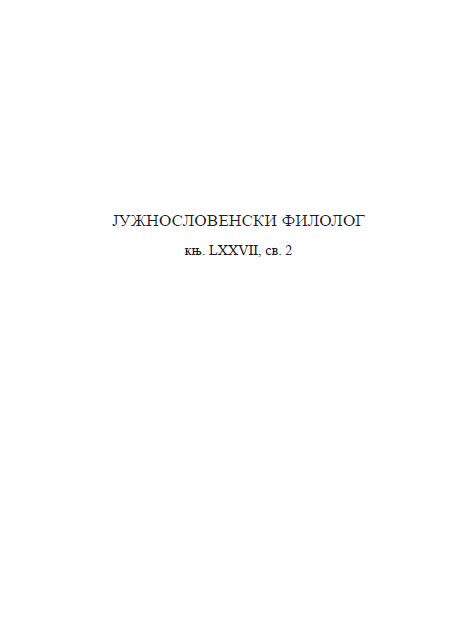ПОГЛЕД НА ПАРТИЦИПСКА ОБРАЗОВАЊА НА -ЋИ, -ВШИ И -М(И) ИЗ УГЛА ЛЕКСИКОГРАФСКОГ ОПИСА САВРЕМЕНОГ СРПСКОГ ЈЕЗИКА
AN OVERVIEW OF THE PARTICIPLES ENDING IN -ЋИ, -ВШИ AND -М(И) FROM THE PERSPECTIVE OF THE LEXICOGRAPHIC DESCRIPTION OF THE CONTEMPORARY SERBIAN LANGUAGE
Author(s): Vladan JovanovićSubject(s): Lexis, Semantics, South Slavic Languages
Published by: Институт за српски језик Српске академије наука и уметности
Keywords: participle forms; grammar; semantics; lexicography; dictionaries; contemporary Serbian language
Summary/Abstract: From the perspective of lexicography, this paper presents an analysis of participles ending in -ћи, -вши and -м(и), which in contemporary Serbian language fall within two categories: 1) the category of contemporary participial continuants, whose action is attributed to the noun as a temporary, current feature at a definite point in time, and 2) the category of adjectives that semantically correspond to past participles or to adjectives proper. As regards the descriptive dictionaries of the contemporary Serbian language, the participles ending in -ћи, -вши and -м(и) are lexicographically treated primarily in the Dictionary of the Serbian Academy of Sciences and Arts (the SASA Dictionary). Comparing the example sentences excerpted from various texts belonging to the contemporary standard Serbian language, on the one hand, with those excerpted from the SASA Dictionary, on the other, it can be noted that the SASA Dictionary does not contain examples of participle forms with the reflexive morpheme -се, while they can be said to be confirmed in other sources. This can be explained as resulting from the impact of the Serbian language norm, according to which participles do not belong to the contemporary standard Serbian language. This is especially true of forms containing the reflexive morpheme -се, which are not to be found in any modern grammar of the standard Serbian language. It is concluded in the paper that the SASA Dictionary treats the participle forms of both aforementioned categories and of three separate participle forms according to the verb tense (past and present) and voice (active and passive). As for the sources confirming the use of these forms, they can be found not only in those dating from the first half of the 19th century, when participles were commonplace in the literary language of Serbs, but also in the works of the 20th-century authors using the contemporary standard Serbian language. In accordance with that, the conclusion to be drawn is that participles should be treated and included in dictionaries, both in those whose compilation is ongoing (i.e. the SASA Dictionary) and in the future dictionaries of the contemporary Serbian language. The excerpted material shows that participles are used by prominent authors in Serbian science, religion and culture. As for the issue of which label to use for the indicated types of participles in the descriptive dictionary of the contemporary Serbian language, it is argued in this paper that in order to resolve it one should take into consideration at least two sets of facts related to the presented material. One refers to the examples of the formation of participles that in fact originate from the older layers of our literary language and which have been preserved in identical or similar form to this day (e.g. одшедши, усопши), while the other concerns participles created in a contemporary synchronic process involving contemporary verbs in current use and their meanings (догоревајућа свећа, плач рађајућих створења, etc.). The former set of examples is marked with standard labels, such as ‘заст.’ (‘obsolete’), ‘арх.’ (‘archaic’), ‘рсл.’ (‘Russian Church Slavonic’), ‘цсл.’ (‘New Church Slavonic’), ‘ссл.’ (‘Serbian Church Slavonic’), ‘сткњ. арх.’ (‘from earlier literary sources, old-fashioned’), used in the lexicographic description of participles in the SASA Dictionary, which can also be used in other descriptive dictionaries of the contemporary Serbian language to indicate the literary epoch in which a particular form of participle originated, or its pragmatic value. Concerning the latter set of participles, if they were to be introduced into a descriptive dictionary of the Serbian language, they would require different labels, since these are the words formed according to the participle-building pattern of the present-day synchronic lexical-grammatical process.
Journal: Јужнословенски филолог
- Issue Year: 77/2021
- Issue No: 2
- Page Range: 157-183
- Page Count: 27
- Language: Serbian

